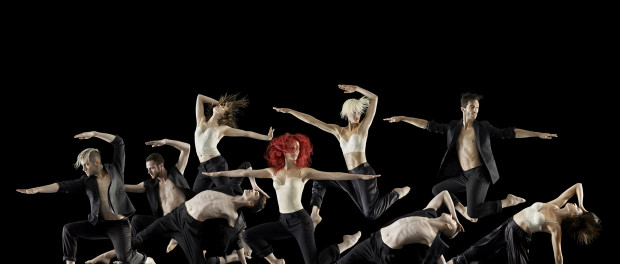Les Ballets Jazz de Montréal: Slick But Lacking Substance
As part of the 2015-16 Danse Danse season, the Ballets Jazz de Montréal is presenting three high-intensity works: Rouge, by the Brazilian choreographer Rodrigo Pederneiras, Mona Lisa by the Israeli choreographer Itzik Galili, and Kosmos by the Greek choreographer Andonis Foniadakis.
Of the three, Rouge was most captivating. Set to powerful music by the Grand brothers that incorporated throat singing, drumming, and the sounds of nature, Rouge is meant to be a tribute to both North and South American indigenous cultures. The dancing was technically flawless, with movements at times reminiscent of disjointed but highly synchronized rag dolls or wooden marionettes, and at other times evocative of Irish or Scottish folk dancing, where the arms are held rather stiffly while the feet execute a series of complex movements. The dancers often held a low center of gravity, shuffling or hopping; sometimes a force rolled through them like water. The intensity was at its highest during a duet that seemed to simulate rape, a visceral exploration of domination and submission, aggression and sexuality.
My main quibble with Rouge though is that it is primarily eye candy, at best bringing the vaguest notion of indigeneity to the minds of the audience, but at worst reinforcing stereotypes and turning us into voyeurs while avoiding any connection to the reality and diversity of Amerindian culture. Vaguely native costumes, arm bands, and face paint, combined with even vaguer allusions to nature and confrontation smack of a desire to make indigenous peoples into a monolithic “other” for our own “self”-ish consumption. Beautiful and technically impressive as it is, Rouge is a vehicle of dance virtuosity colored red in order to create an exotic but ultimately vacuous morsel of cultural appropriation for our consuming pleasure.
The second work on the program, Mona Lisa, riffed on the classical pas de deux. Technically impressive, male and female play a game of seduction in a carefully choreographed interplay that brings to mind the precise mechanism of clockwork. The rhythmic rigour is reinforced by the score, which is comprised of the mechanical sounds of typewriters.
The last piece, Kosmos, featuring music by Julien Tarride, was meant to evoke the frenzy of urban living, the manic motions of crowds. It was, indeed, hectic, arms and legs constantly being thrown in different directions, the high-speed group choreography intricate and elaborate. However, in my opinion, the highlight was the almost nude male solo towards the end of the work. Here there seemed to be something concrete and human that was communicated, as opposed to the frenzied running to and fro that left me a little cold. The ending was also interesting, as the stage was washed in a sort of throbbing strobe light, turning the dancers into a myriad of stars merging in and out of different formations. Even this, however, went on a little long, appearing finally to be a little gimmicky and devoid of meaning or depth.
BJM is definitely worth seeing if you crave a dose of shiny technical proficiency and impressive and interesting but somewhat superficial virtuosity. If you’re looking for any kind of authenticity or profundity, however, don’t waste your time.
BJM plays as part of the Danse Danse season. December 2-5 at 8pm at Thatre Maisonneuve of Place des Arts. Tickets $34.25-63.25. Call 514-842-2112 or wwww.pda.qc.ca.







